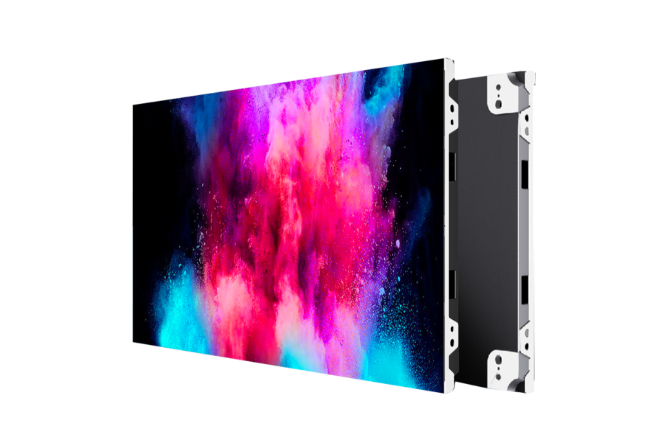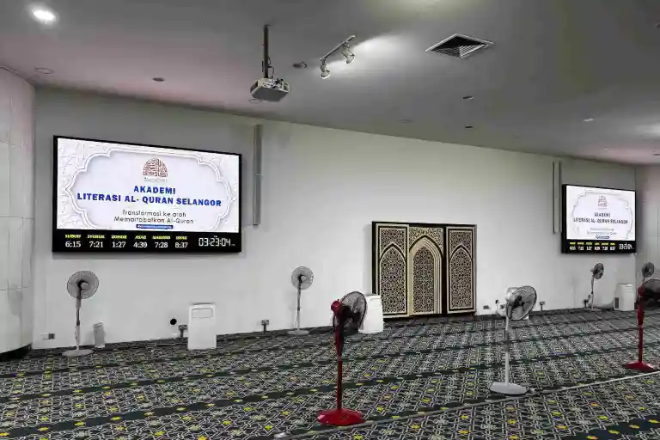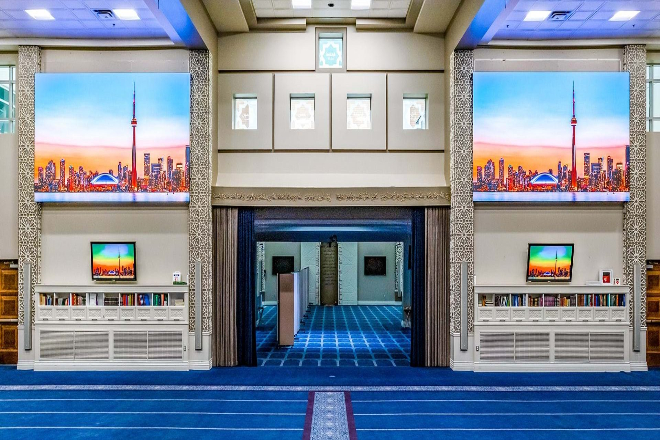介绍

With the advancement of technology and the demand for religious and cultural propaganda, the application of LED显示屏 in mosques is becoming more and more widespread.
However, unlike general commercial or public places, mosques, as spaces with profound cultural heritage and religious significance, have a series of special requirements for the use of LED display screens.
目录
1. Analysis of the architectural characteristics of mosques and the adaptability of LED display screens
1). Architectural characteristics of mosques
As a holy place of Islam, the mosque not only carries the solemnity and sacredness of religion but also integrates the cultural customs of various places to form a unique architectural style.
When you walk into a mosque, you will first feel its directionality. The prayer hall, where believers pray devoutly, always faces Mecca firmly.
This layout allows every believer to feel the connection with the holy land when praying as if the soul has crossed thousands of mountains and rivers and reached that distant and sacred place.
Inside the mosque, you can’t find any sculptures of idols or figures. Islam emphasizes the supremacy of Allah, so the decorations here are mostly geometric patterns, floral patterns and Arabic calligraphy.
These decorations are both simple and profound, allowing people to feel the charm of religion while appreciating them.
2). Adaptability of LED display screen:
LED display screen, a product of modern technology, has now entered the mosque, adding new colors to the religious activities here.
2.1). Adapt to the special environment of the mosque:
As a religious place, mosques often need to run display devices for a long time. The low energy consumption characteristics of LED display screens are tailor-made for mosques.
It can not only effectively reduce operating costs but also reduce energy waste, which is in line with the spirit of conservation advocated by Islam.
Moreover, LED display screens have a long service life and low maintenance costs. This is undoubtedly good news for mosques.
Because what mosques need is a stable and reliable display device, not a “trouble” that needs frequent repairs or replacements.
Furthermore, mosques may be located in earthquake-prone areas or humid environments.
The earthquake-resistant and waterproof characteristics of LED display screens are like a solid barrier, ensuring that they can still work normally in harsh environments and provide accurate information to believers.
2.2). Improve the efficiency of information dissemination and religious activity experience in mosques
The application of LED display screens in mosques is not just a display device. It is more like a disseminator of information and an assistant to religious activities.
Through LED display screens, mosques can display religious activity information, notices, etc., in real-time. In this way, believers can learn about the latest activity arrangements for the first time, which is convenient for them to participate in religious activities.
Moreover, the display effect of LED display screens is clear and bright, allowing everyone to see the information clearly, even in crowded places.
More importantly, LED display screens can also enhance believers’ sense of participation and interaction.
Imagine playing related video content through LED display screens during religious lectures or reciting scriptures, allowing believers to feel the charm of religion more intuitively.
This new way of experience will undoubtedly attract more believers to participate in religious activities.
2. Installation requirements for LED display screens in mosques

It is not a casual thing to install LED display screens in mosques. The architectural characteristics of the mosque, the flow of people, and safety regulations must be taken into account to make the display screen both beautiful and practical.
1). Installation location selection:
1.1). Look at the architectural layout:
The mosque buildings have their own styles; some are courtyards, and some have tall bunker buildings.
When choosing the location of the LED display screen, you have to think about whether the display screen matches the overall style of the mosque and doesn’t make it out of place.
1.2). Think about how people flow:
When there are many people in the mosque, how do people flow? You have to find a place where everyone can see the display screen, such as the entrance of the prayer hall, under the Bunker Building, or in the middle of the courtyard.
In this way, no matter where everyone comes from, they can see the content on the screen at a glance.
1.3). Consider both sight and traffic:
The display screen should be installed so people can see it clearly. Don’t install it too high or too low so that people look up or down. Also, don’t block the road, which makes it inconvenient for people to walk around.
2). Choose the installation method:
The LED display screen can be wall-mounted, suspended, or embedded in the wall. Which method to choose depends on the actual situation of the mosque, as well as the size and weight of the display screen.
2.1). Wall-mounted is quite convenient:
If the wall of the mosque is quite strong and flat, then the wall-mounted type is quite good. It is easy to install and has no effect on the building.
2.2). Suspended type is quite conspicuous:
The space in the mosque is high, and you want everyone to see the display screen at a glance, so the suspended type is quite good. Hang it high so that everyone can see it.
2.3). Embedded is beautiful:
If you want the display screen to blend into the mosque and look more beautiful, then choose embedded. Embed the display screen into the wall or decoration as if it is already there.
However, no matter which installation method you choose, safety is the first priority. Be careful when installing it; don’t hurt people, and don’t damage the building of the mosque.
3). Selection of brackets and fixing frames:
LED display screens are large and small, light and heavy. When choosing a bracket or fixing frame, you have to look at the specific size and weight of the display screen; don’t choose the wrong one.
The bracket or fixing frame must be installed firmly, don’t shake. It must also be installed flat, not crooked. In this way, the display screen can be hung on it steadily.
In addition, the bracket or fixing frame must be selected to meet national safety standards, and it must be checked after installation to ensure that there is no problem. In this way, everyone can use it with confidence.
In general, installing LED display screens in mosques is not a simple matter. You have to choose a good location, installation method, bracket and fixing frame.
You have to take into account the architectural characteristics of the mosque and the flow of people, and you have to comply with safety regulations.
In this way, the display screen can be both beautiful and practical, bringing everyone a better religious experience.
3. Electrical requirements for LED display screens in mosques
When installing LED display screens in mosques, the electrical requirements cannot be sloppy. After all, electrical safety is directly related to the normal operation of the display screen and the safety of users.
1). 电源 要求:
1.1). Power supply voltage and frequency:
LED display screens have requirements for the power supply voltage and frequency. Generally speaking, the power supply voltage must be stable, not high and low, and the frequency must be correct so that the display screen can work normally.
We have to choose a suitable power supply, preferably one that can output stably and with small fluctuations so that the display screen can be used with confidence.
1.2). Safe earth contact:
Safe earth contact is the highlight of electrical safety. Make sure that the ground wire is connected securely, and the ground wire and the neutral wire must be separated and not mixed together.
When connecting to the power supply, you must stay away from high-power devices to prevent them from interfering with the power supply of the display and affecting the display effect.
2). Layout of power lines and signal lines:
2.1). Layout requirements:
The power lines and signal lines must be arranged in an orderly manner and not crossed to avoid mutual interference.
The power line goes the way of the power line, and the signal line goes the way of the signal line. They go their own way and do not interfere with each other.
Also, please note that these lines must be fixed and not swaying so as not to accidentally touch each other one day, causing safety hazards.
2.2). Firmness and stability of connecting wires:
The connecting wires are the bridge between the display and the power and signal source.
Make sure that these connecting wires are connected firmly and not loose, so as to avoid abnormal signal transmission and affect the display effect.
Check the connecting wires regularly. If they are found to be loose or damaged, replace or fix them immediately to prevent small problems from becoming big problems.
3). Lightning protection and grounding protection:
3.1). Lightning protection measures:
Bad weather, especially strong thunder and lightning weather, is a big test for LED display screens.
Lightning protection measures must be taken, such as installing lightning arresters, lightning rods, etc., to ensure that the display screen is safe and sound in thunderstorms.
Also, it should be noted that the metal parts of the display screen must be connected to the ground wire, and no “minefield” should be left to avoid being damaged by lightning.
3.2). The importance of grounding protection:
Grounding protection is the last line of defense in electrical safety.
Make sure that the grounding wire is connected securely and that the grounding resistance meets the requirements so that the current of the lightning strike can be led to the ground and the display screen can be protected from damage.
Check the grounding wire and grounding resistance regularly. If there is a problem, deal with it immediately, and don’t wait until the lightning strikes to regret it.
In general, the electrical requirements for using LED display screens in mosques are not low. Make sure that the power supply is stable, the power lines and signal lines are arranged in an orderly manner, and the lightning protection and grounding protection are in place.
Only in this way can the display screen work safely and steadily in the mosque and bring a better visual experience to the believers.
4. Requirements for the use and maintenance of LED display screens in mosques

The LED display screens in mosques are important tools for information dissemination and beautification. Their use and maintenance are crucial.
Correct use methods and meticulous maintenance measures can not only ensure the long-term stable operation of the display screen but also enable it to always present the best display effect.
1). Usage requirements:
1.1). Correct opening and closing sequence:
The opening and closing of LED display screens need to follow a certain sequence. When turning on, the control host should be turned on first, and then the display screen should be turned on after it runs stably.
This ensures that the display screen works normally after receiving a stable signal source, avoiding bright spots on the screen or burning the lamp tube. When turning off, the display screen should also be turned off first, and then the control host.
This can avoid abnormal bright spots when the control host is turned off due to the sudden loss of signal source.
1.2). Avoid long-term high-亮度 playback:
Although the LED display screen has high brightness and bright colors, long-term playback of full-white images with the highest brightness will cause a greater burden on the display screen.
Excessive brightness will cause excessive current, cause the power cord to heat up, and may even damage the LED lamp.
Therefore, during use, you should try to avoid playing full white or high-brightness images for a long time to reduce the burden on the display and extend its service life.
1.3). Reasonable adjustment of brightness and contrast:
According to the light environment and viewing distance in the mosque, reasonably adjust the brightness and contrast of the LED display.
Too high brightness not only wastes energy, but also may irritate the viewer’s eyes; too low brightness may affect the display effect.
Therefore, it should be adjusted according to the actual situation to achieve the best viewing effect.
2). Maintenance requirements:
2.1). Clean the surface regularly:
The surface of the LED display is prone to dust and dirt, which will affect the display effect. Therefore, the surface of the display should be cleaned regularly with a clean soft cloth or professional cleaning tools.
During the cleaning process, avoid using corrosive or abrasive detergents to avoid damage to the surface of the display.
2.2). Check the power cord and signal cable:
The power cord and signal cable are important components of the LED display, and their connection status directly affects the normal operation of the display.
Therefore, the power cord and signal cable should be checked regularly to see if they are firmly connected, worn or loose.
Once a problem is found, it should be dealt with immediately to avoid display screen failure due to line problems.
2.3). Regularly check the display screen lamp beads:
The lamp beads of the LED display screen are the key components of the display screen, and the working status of the lamp beads should be checked regularly.
If it is found that some lamp beads are not lit or the brightness is abnormal, they should be replaced or repaired in time to avoid affecting the overall display effect.
2.4). Regularly upgrade the control system:
With the continuous advancement of technology, the control system of the LED display screen is also constantly updated and upgraded. The new control system usually has better performance and more functions, which can improve the display effect and user experience of the display screen.
Therefore, attention should be paid to the upgrade notification of the display screen manufacturer, and the control system should be upgraded in time to maintain the advancement and stability of the display screen.
In summary, the use of LED display screens in mosques needs to follow standardized operating methods and perform meticulous maintenance work.
Through correct use and maintenance, the long-term stable operation and optimal display effect of the display screen can be ensured, adding a touch of brightness and color to the mosque.
5. Environmental requirements for the use of LED display screens in mosques
The LED display screen in the mosque is like a display stand in the temple, conveying information and decorating the environment.
However, this display stand is very delicate and needs to be taken good care of, especially in the working environment.
The LED display screen has a comfortable working temperature range, which is about -10℃ to 40℃. As for humidity, it is best to be 10% to 90%RH. Don’t let it be too dry or too wet. Just like us, we need a suitable environment to work well.
If it is too hot or too cold, the small parts in the LED display screen may “go on strike” and will not display a good-looking picture.
Too high humidity is not good either, as water droplets may condense inside and damage the circuit.
In addition, it is extremely hot in summer, cold in winter, and wet in the rainy season. You have to be especially careful at these times. Try not to let the LED display screen work or store for a long time during these times.
Otherwise, it may “get sick.” If there is really no other way, you have to find a way to cool it down and dehumidify it to make it more comfortable.
There are a lot of people coming and going into the mosque, so there is a lot of dust and insects. Dust will run into the LED display, making it unclear; insects are even more hateful and may bite the circuits or parts inside.
You have to “bathe” the LED display regularly, wipe the surface with a clean cloth, and then blow away the dust inside. You can also put on a “dust-proof coat” or “insect-proof net” so that dust and insects cannot get in.
You have to check from time to time to see if there are any insects messing around inside, and if you find them, you have to deal with them quickly.
If the LED display is not used for a long time, especially in a high humidity place, a lot of moisture may accumulate inside. When it is used again, the moisture may cause the circuit to short-circuit or damage.
There is a good way, that is, after a long time of non-use, don’t turn it on too brightly, let it slowly “wake up”, and drive away the moisture inside.
Just like we will feel uncomfortable when we suddenly get up after sleeping for a long time, the LED display also needs to “warm up”. In this way, it can serve us better.
In short, the LED display screen in the mosque is like our good friend, and we need to take good care of it.
Pay attention to temperature, humidity, dust and insect prevention, and “warm up” it when it is not used for a long time. In this way, it can always stay bright and healthy!
6. Cultural and religious requirements for the use of LED display screens in mosques

As a holy place of Islam, every detail of the mosque carries profound religious and cultural connotations.
As a product of modern technology, the application of LED display screens in mosques must also strictly follow Islamic doctrines and cultural traditions to ensure that its content and form are in harmony with the religious atmosphere.
Next, let’s talk about the cultural and religious requirements for the use of LED display screens in mosques.
1). Content review:
The content played on the LED display screen must strictly comply with the teachings of Islam.
This means that any content that is contrary to the teachings of Islam and may cause controversy or misunderstanding must never appear on the display screen. This is a respect for Islam and a care for the emotions of believers.
Islam has a long history and rich cultural traditions. When playing content, the LED display screen should fully respect these cultural traditions and show the beauty and wisdom of Islam.
For example, you can play some short films about Islamic history, doctrines, and Hadith or display some works of art with Islamic characteristics.
2). Playback schedule:
Mosques have a fixed schedule for religious activities, such as five daily prayers, weekly congregational prayers, and annual Eid al-Fitr and Eid al-Adha.
The playback time of the LED display should be closely arranged around these religious activities to ensure that appropriate content is played at the right time to add atmosphere to religious activities.
The work and rest time of believers is also a factor that needs to be considered when arranging the playback time of the LED display.
For example, when believers are praying or resting, they should try to avoid playing too noisy or dazzling content to avoid interfering with the religious life and the rest of the believers.
3). Respect for believers’ feelings:
When designing the playback content and form of the LED display, the feelings and needs of believers should be fully considered.
For example, the language of the content should be selected in a language familiar to believers, and the design of the picture should conform to the aesthetic concept of Islam, avoiding the use of overly exaggerated or potentially uncomfortable elements.
The playback of the LED display should try to avoid unnecessary interference or discomfort to believers.
For example, the volume of the playback should be moderate, not too loud or too low; the brightness of the picture should also be moderate, not too bright or too dark, so as not to irritate the eyes of believers.
In short, when using LED display screens in mosques, they must strictly abide by Islamic doctrines and cultural traditions, arrange the playback time reasonably, and fully consider the feelings and needs of believers.
Only in this way can we ensure that LED display screens play a positive role in mosques, add atmosphere to religious activities, and provide convenience and services for believers.
七、结论
Using LED display screens in mosques can not only improve the efficiency of information dissemination, but also provide more convenient services for believers.
However, in the application process, the particularity of mosques must be fully considered, and strict control must be exercised from content display, color selection to brightness adjustment to ensure compliance with Islamic belief requirements and etiquette norms.
最后,如果你想了解更多关于LED显示屏的信息, 请与我们联系。
